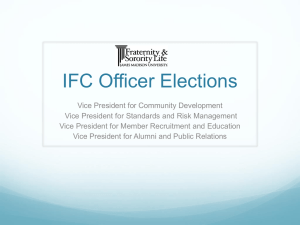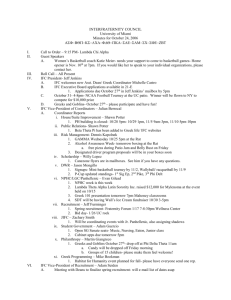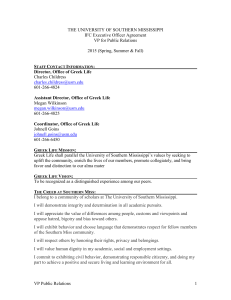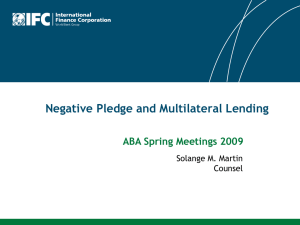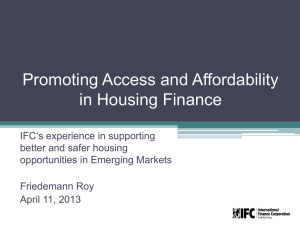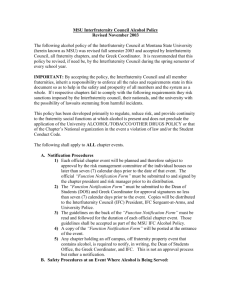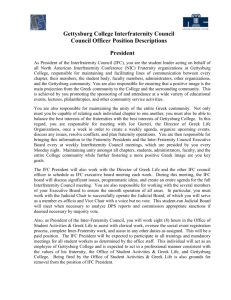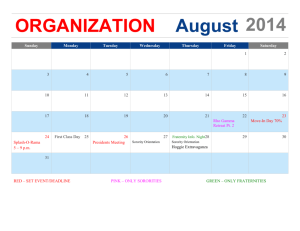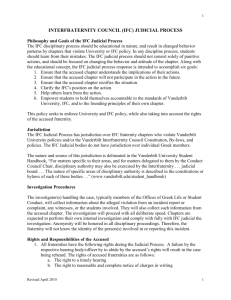Applying Student Development Theories to Culture C
advertisement
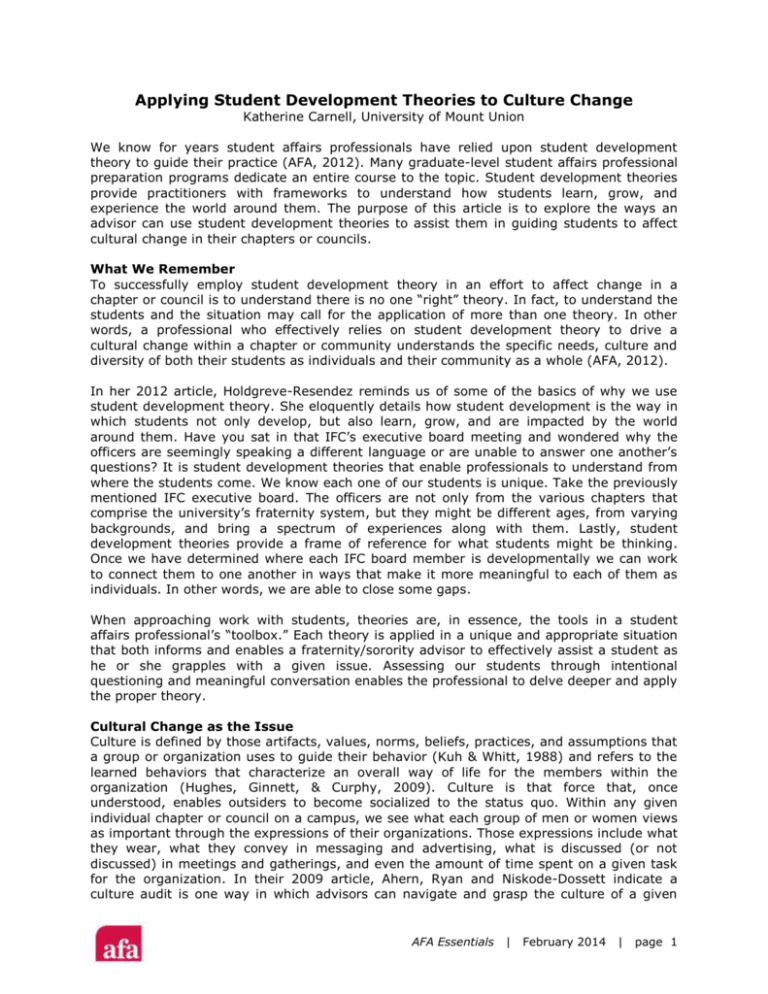
Applying Student Development Theories to Culture Change Katherine Carnell, University of Mount Union We know for years student affairs professionals have relied upon student development theory to guide their practice (AFA, 2012). Many graduate-level student affairs professional preparation programs dedicate an entire course to the topic. Student development theories provide practitioners with frameworks to understand how students learn, grow, and experience the world around them. The purpose of this article is to explore the ways an advisor can use student development theories to assist them in guiding students to affect cultural change in their chapters or councils. What We Remember To successfully employ student development theory in an effort to affect change in a chapter or council is to understand there is no one “right” theory. In fact, to understand the students and the situation may call for the application of more than one theory. In other words, a professional who effectively relies on student development theory to drive a cultural change within a chapter or community understands the specific needs, culture and diversity of both their students as individuals and their community as a whole (AFA, 2012). In her 2012 article, Holdgreve-Resendez reminds us of some of the basics of why we use student development theory. She eloquently details how student development is the way in which students not only develop, but also learn, grow, and are impacted by the world around them. Have you sat in that IFC’s executive board meeting and wondered why the officers are seemingly speaking a different language or are unable to answer one another’s questions? It is student development theories that enable professionals to understand from where the students come. We know each one of our students is unique. Take the previously mentioned IFC executive board. The officers are not only from the various chapters that comprise the university’s fraternity system, but they might be different ages, from varying backgrounds, and bring a spectrum of experiences along with them. Lastly, student development theories provide a frame of reference for what students might be thinking. Once we have determined where each IFC board member is developmentally we can work to connect them to one another in ways that make it more meaningful to each of them as individuals. In other words, we are able to close some gaps. When approaching work with students, theories are, in essence, the tools in a student affairs professional’s “toolbox.” Each theory is applied in a unique and appropriate situation that both informs and enables a fraternity/sorority advisor to effectively assist a student as he or she grapples with a given issue. Assessing our students through intentional questioning and meaningful conversation enables the professional to delve deeper and apply the proper theory. Cultural Change as the Issue Culture is defined by those artifacts, values, norms, beliefs, practices, and assumptions that a group or organization uses to guide their behavior (Kuh & Whitt, 1988) and refers to the learned behaviors that characterize an overall way of life for the members within the organization (Hughes, Ginnett, & Curphy, 2009). Culture is that force that, once understood, enables outsiders to become socialized to the status quo. Within any given individual chapter or council on a campus, we see what each group of men or women views as important through the expressions of their organizations. Those expressions include what they wear, what they convey in messaging and advertising, what is discussed (or not discussed) in meetings and gatherings, and even the amount of time spent on a given task for the organization. In their 2009 article, Ahern, Ryan and Niskode-Dossett indicate a culture audit is one way in which advisors can navigate and grasp the culture of a given AFA Essentials | February 2014 | page 1 student organization enabling one to intentionally learn more about what is important to the group. Using a detailed process of discovery, an advisor can use one-on-one conversations, document analysis, and observations as ways in which to interpret the culture of the chapter or council (Ahern, Ryan & Niskode-Dossett, 2009). However, they point out one very important consideration: “keep in mind that culture cannot be manipulated on a whim; only careful and intentional conversations that appropriately examine the nature of group values and beliefs can begin the process of changing organizational culture” (Ahren, Ryan, & Niskode-Dossett, 2009, p. 31). Knowing how to approach those conversations through a framework of various theories enables advisors to make those intentional conversations developmentally appropriate. Continuing with the example from earlier, what if the culture on campus supports the notion that IFC really is not a functioning organization? Shertzer’s (2010) blog entitled, “A Serious IFC – Part 1” describes a not-so-functional council very well. He details an IFC which fails to have meetings with any kind of purpose, has the wrong people are in the room to hear information that is not always conveyed accurately, where no one really knows what IFC actually is (“what is a governing board, anyway?”), with IFC officers and delegates who do not really know their purpose for existence, and where no one has the ability to take a stand in issues deemed to be important. If culture is set by behaviors, and if those behaviors are not understood by its members because of where they are on the vector chart or ethical development continuum, how does the collective “we” hope to affect change? Through continued study and deliberate implementation of student development theories, I have come to know how to recognize where a young man “is” and how to elevate our conversation by approaching each officer, delegate or member in such a way that he is able to feel empowered to take appropriate action. Foriska (2004) says it well – “the greatest ability to affect change in our students is by guiding them through the transitions in their own development” (2004, p. 1). Students first need to begin to understand themselves if they ever hope to understand the world that surrounds them. Knowing that the dualistic thinker would see the president, officers, and/or advisor as “the authority,” I know I can empower him to think differently by challenging him with tasks to complete in order to accomplish his goal, followed by support as he completes (or continued challenge as he fails to complete) them. The flip side of this is also acknowledging there are those students who will never actualize past a certain point. For example, knowing some young people will not ever develop past dualism or will not ever develop autonomy toward interdependence (Chickering & Reisser, 1993) where they will begin to understand their place in relation to a larger community can guide a fraternity/sorority advisor; for example, it is in the aforementioned stages where their sense of personal responsibility becomes more about mutual giving and interdependence, rather than only using others for approval (AFA, 2012). In this example, it might be valuable to counsel an organization out of electing specific individuals to office. However, helping each of the students to know when they see their members giving up, feeling burnt out, or demonstrating total apathy, it may be in part to those individuals being in the process of questioning the world around them. Furthermore, those members may be confused on how to navigate the transition. Moving from duality to a multiplistic point of view, or moving from understanding their place in a community to understanding how they impact their community, can cause some serious distress and can upset the ways in which the organization as a whole functions. And knowing that is, after all, half the battle. Right? AFA Essentials | February 2014 | page 2 References Ahren, C., Ryan, H. G., Niskode-Dossett, A. S. (2009). Making the familiar strange: How a culture audit can boost your advising impact. About Campus, 14(1), pp. 25-32. Association of Fraternity & Sorority Advisors. (2012). Student development theory resource guide: Application in fraternity/sorority advising. Foriska, K. (2004). Slamming students through the vectors: Recognizing the need for continuous development. Essentials. Holdgreve-Resendez, K. D. (2012). The challenge in providing support is in supporting the challenge. Campus Activities Programming, 17-19. Hughes, R. L., Ginnett, R. C., & Curphy, G. J. (2009). Leadership: Enhancing the lessons of experience. 6th Edition. New York, NY: McGraw-Hill Irwin Publishers. Kuh, G., Schuh, J. H., Whitt, E. J., & Associates. (1991). Involving colleges: Successful approaches to fostering student learning and development outside the classroom. San Francisco, CA: Jossey-Bass Publishers. Kuh, G. & Whitt, E. J. (1988). The invisible tapestry: Culture in American colleges and universities. ASHE-ERIC Education Report, 17(1). Washington, DC: The George Washington University, Graduate School of Education and Human Development. Shertzer, J. (2010, April 19). A Serious IFC – Part 1 of 2. [Web log comment]. Retrieved from http://fraternalthoughts.blogspot.com/2010/04/serious-ifc-part-1-of-2.html AFA Essentials | February 2014 | page 3

